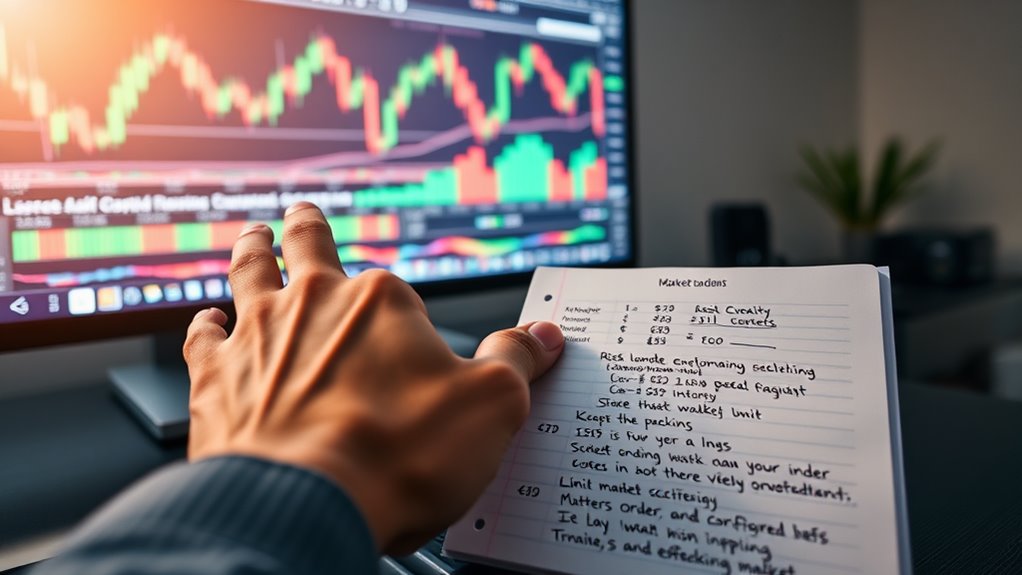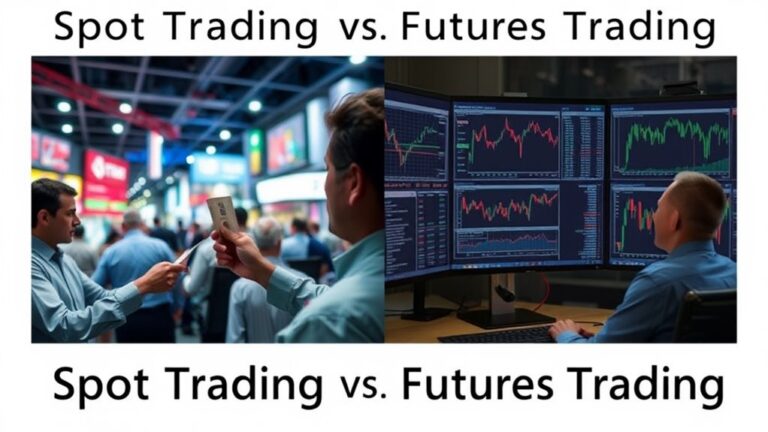
How to Use Limit and Market Orders: A Beginner’s Guide to Trading Cryptocurrency Efficiently
Market orders execute immediately at the best available price, prioritizing speed over cost. Limit orders establish precise entry points at specific prices, offering better control but no guarantee of execution. Choose market orders in stable, liquid markets when speed matters, and limit orders during volatility or for specific price targets. Effective risk management combines both types with stop-loss orders to protect investments. Understanding fee structures can optimize trading costs across different exchanges. Additional techniques await traders ready to advance their cryptocurrency strategies.
Key Takeaways
- Market orders execute instantly at current price, prioritizing speed over cost in highly liquid markets.
- Limit orders allow you to set specific buy/sell prices, offering better price control during market volatility.
- Beginners should start with limit orders to avoid slippage and potentially get better prices than market rates.
- Maker-taker fee structures typically charge lower fees for limit orders (makers) than market orders (takers).
- Use market orders when immediate execution is crucial and limit orders when specific entry/exit points matter more.
The Fundamentals of Cryptocurrency Market Orders

Market orders represent the most straightforward mechanism for executing cryptocurrency trades. They execute immediately at the best available price in the market, making them ideal for traders who prioritize speed over exact price points.
While market orders offer instant execution, they come with notable trade-offs, including higher fees and a lack of price control.
The effectiveness of market orders largely depends on market conditions. In highly liquid markets, these orders typically execute close to the expected price. However, during volatile periods or in thinly traded markets, slippage can occur, resulting in less favorable execution prices.
Traders often employ market orders when responding to breaking news, capturing breakout movements, or quickly exiting positions to minimize losses. Despite their simplicity, market orders require careful consideration of timing and market conditions. Additionally, understanding risk management strategies is crucial for maximizing potential profits while minimizing losses in trading.
Mastering Limit Orders for Precise Crypto Trading

Limit orders enable traders to establish precise entry points at specific price levels, giving them control over when and how they enter cryptocurrency positions.
Patient traders who utilize limit orders often secure more favorable prices than those who rush into trades with market orders, potentially improving their overall profitability.
Setting strategic limit orders based on support and resistance levels, technical indicators, or price patterns allows investors to execute their trading plans with discipline rather than emotion, a critical factor in successful cryptocurrency trading. Additionally, understanding trading fees can help investors make more informed decisions about their limit orders and overall trading strategy.
Setting Perfect Entry Points
When traders aim for ideal results in cryptocurrency markets, setting perfect entry points becomes a critical skill that can greatly impact profitability. Limit orders provide traders with precise control over these entry positions, allowing them to specify exact prices at which they want to purchase crypto assets.
This approach particularly shines in volatile markets where buying at predetermined price levels can protect against unfavorable movements.
- Buy limit orders execute at the specified price or lower, making them ideal for capturing assets during price dips.
- Support and resistance levels serve as strategic points for placing limit orders based on technical analysis.
- Dollar-cost averaging can be effectively implemented using limit orders set at regular intervals. Additionally, understanding order book depth can help traders assess market liquidity and set more informed limit orders.
Patience Yields Profits
Successful cryptocurrency traders understand that patience with limit orders often separates profitable strategies from unsuccessful ones. While market orders offer immediacy, limit orders reward the disciplined investor who waits for ideal price points, particularly during market volatility.
| Strategy | Patient Approach | Potential Benefit |
|---|---|---|
| Entry Points | Setting orders below market price | Buying at support levels |
| Position Building | Staggered limit orders at decreasing prices | Lower average cost basis |
| Volatile Markets | Placing orders at pre-determined levels | Protection from price swings |
| Selling Positions | Setting orders above current price | Capturing price rallies |
| Dollar-Cost Averaging | Regular limit orders at set intervals | Systematic accumulation |
This methodical approach prevents emotional trading decisions and guarantees traders execute their strategy according to plan rather than reacting impulsively to market fluctuations. Additionally, adopting security measures such as multi-factor authentication can further protect your investments while trading efficiently.
When to Choose Market vs. Limit Orders in Crypto Exchanges

Deciding between market and limit orders represents one of the most fundamental choices traders face in cryptocurrency exchanges. Market orders prioritize immediate execution at the best available price, making them ideal during stable market conditions and for highly liquid assets like Bitcoin.
Limit orders, meanwhile, offer precise price control but without guaranteed execution, functioning best for volatile markets and less liquid cryptocurrencies.
- Market conditions matter – Use market orders in stable periods and limit orders during volatility or news events.
- Consider asset liquidity – Market orders work better for large-cap cryptocurrencies while limit orders protect against slippage in small-cap trading.
- Evaluate your priorities – Choose market orders when speed is critical; select limit orders when specific price points are essential to your strategy. Understanding trading pairs can further enhance your order execution strategy.
Risk Management Strategies Using Order Types

Effective cryptocurrency traders implement stop-loss orders to limit potential losses by automatically exiting positions when prices fall below predetermined thresholds.
Position sizing tactics, such as allocating only 1-5% of capital per trade, help manage overall portfolio risk while preserving capital for future opportunities.
During periods of extreme market volatility, traders should select order types that match current conditions, often choosing limit orders for better price execution in choppy markets and market orders when quick position establishment is necessary. Moreover, traders should consider using exchanges with robust security features to ensure their assets are protected during trading activities.
Stop-Loss Order Essentials
The foundation of prudent cryptocurrency trading lies in understanding and implementing stop-loss orders effectively. These conditional orders automatically execute when an asset reaches a predetermined price, limiting potential losses during market downturns.
Stop-loss orders serve as an essential risk management tool, particularly in cryptocurrency markets known for significant volatility.
- Types of Stop-Loss Orders: Full stop-loss for complete position exit, partial stop-loss for reducing exposure, and trailing stop-loss that adjusts with market movement.
- Emotional Protection: Automated stops remove emotional decision-making influenced by fear or greed during rapid price changes.
- Strategic Limitations: Be aware that traditional stop-losses may trigger prematurely during temporary volatility, and market gaps can result in executions at prices worse than anticipated. Additionally, securing your crypto assets through secure wallets is crucial to mitigate risks associated with trading.
Position Sizing Tactics
While stop-loss orders protect traders from unexpected losses, proper position sizing represents the foundation of thorough risk management in cryptocurrency trading. Traders typically employ several strategies to determine appropriate position sizes.
The fixed dollar approach allocates the same amount to each trade regardless of market conditions, while fixed percentage strategies risk a consistent portion of trading capital.
More sophisticated traders may implement volatility-adjusted sizing, which accounts for current market conditions when determining position size. The Kelly Criterion offers a mathematical approach based on win rates and risk-reward ratios.
When calculating position size, conservative traders often risk only 1% of their capital per trade. This calculation must incorporate stop-loss placement and consider current market volatility to maintain consistent risk exposure, especially when using leverage. Additionally, effective position sizing can enhance strategies like crypto lending, allowing traders to leverage their assets while managing risk effectively.
Volatility-Based Order Selection
Many successful cryptocurrency traders adapt their order selection strategies based on prevailing market volatility conditions.
When volatility increases, the choice between market and limit orders becomes increasingly critical to trading success. Market orders provide immediate execution but potentially higher slippage during volatile periods, while limit orders offer price precision but may not execute during rapid price movements.
- High Volatility Periods: Consider limit orders to avoid excessive slippage, especially when ATR indicators show expanding ranges.
- Low Volatility Periods: Market orders may be appropriate when quick execution is needed and price movement risks are minimal.
- Breakout Scenarios: Implement stop-limit orders at key resistance or support levels to capitalize on volatility expansions while maintaining risk control.
Adjusting order strategies based on current and forecasted volatility helps protect capital while positioning for potential opportunities. Additionally, utilizing exchanges with user-friendly interfaces can enhance the overall trading experience during volatile market conditions.
Optimizing Fee Structures for Different Order Types

Strategic selection of order types can dramatically reduce trading costs while maximizing position advantages in cryptocurrency markets. Most exchanges implement a maker-taker fee model, where limit orders (makers) enjoy lower fees than market orders (takers). For example, Coinbase charges 0.40% for makers versus 0.60% for takers on trades under $10,000.
Traders should consider their priorities when selecting order types. Market orders provide immediate execution but at higher costs, making them suitable when timing outweighs price concerns. Conversely, limit orders offer preferable rates for patient traders targeting specific prices.
Additionally, increasing trading volume can qualify users for reduced fee tiers, while holding exchange native tokens like BNB can activate further discounts. Trading during high-liquidity periods also helps optimize execution and minimize costs. Furthermore, users must complete identity verification before they can access certain features, including trading, on many exchanges.
Advanced Order Techniques for Volatile Crypto Markets

Steering through volatile cryptocurrency markets requires advanced order techniques that go beyond basic buying and selling. Experienced traders combine various order types to create sophisticated strategies that can protect investments while capitalizing on market movements.
- Stop-limit orders merge stop and limit functionalities, triggering at a specific price but executing only within a predetermined range, providing better price control in rapid market shifts.
- OCO (One-Cancels-the-Other) orders pair two conditional orders together, automatically canceling one when the other executes—ideal for setting both take-profit and stop-loss positions simultaneously.
- Take-profit orders automatically close positions when reaching profit targets, securing gains without requiring constant market monitoring—particularly valuable during high volatility periods.
Frequently Asked Questions
Can I Cancel a Limit Order After It’s Been Placed?
Traders can cancel limit orders if they haven’t been executed yet. This action typically requires accessing the trading platform’s interface, selecting the specific order, and paying any associated network fees for cancellation.
How Do Partial Fills Work With Limit Orders?
Partial fills occur when a limit order is executed only partially due to insufficient liquidity or price movements. The filled portion completes at the specified price while the remainder stays open until canceled or fully executed.
Do Limit Orders Affect Overall Market Price Movements?
Like ripples on a pond, individual limit orders typically have minimal impact on market prices. However, concentrated limit orders at specific price points can collectively influence market dynamics, especially in illiquid or volatile conditions.
What Happens to My Orders During Exchange Maintenance Periods?
During exchange maintenance periods, orders are typically placed on hold, not executed, and may not be visible or manageable until maintenance completes. Trading resumes after system updates and order books are refreshed accordingly.
Should Beginners Practice With Small Amounts Before Large Trades?
Beginners should practice with small amounts before committing to large trades. This approach allows for practical experience with real market dynamics while minimizing potential losses during the learning process.
Conclusion
Understanding order types transforms cryptocurrency trading from a chaotic gamble into a strategic endeavor. Market orders offer lightning-fast execution when every second counts, while limit orders provide precision control over entry and exit points. By mastering both techniques and knowing when to deploy each, traders can navigate the wildest market storms with confidence, minimize costly fees, and build a robust foundation for long-term success in the digital asset space.












